
At home up in the mountains: Dino Mattioli and his Arocs
Story
When the construction site is high up in the mountains, transporting building materials becomes a challenge. On the move in the Dolomites with Dino Mattioli and his Arocs.
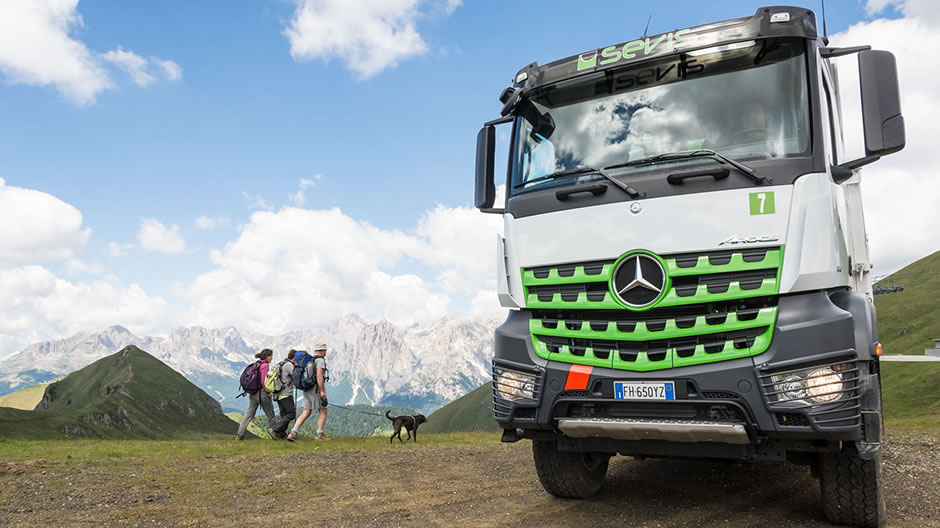
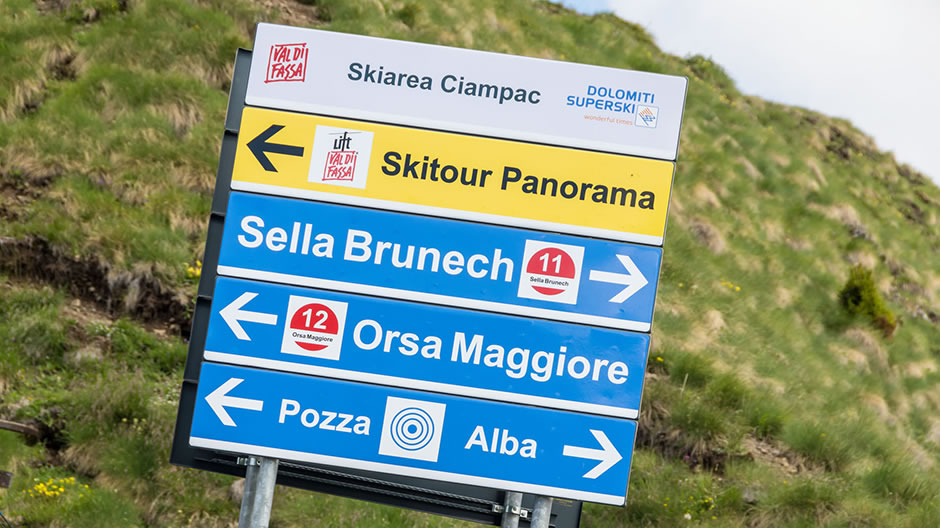
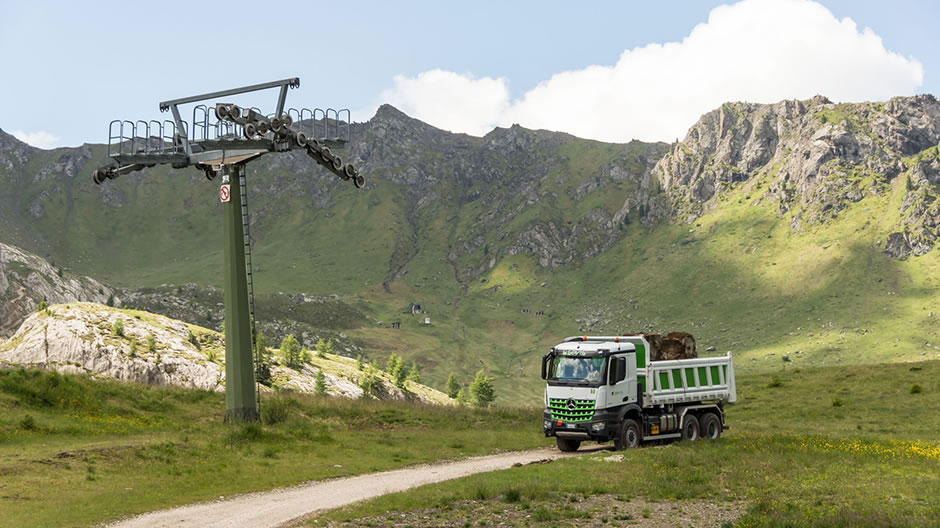
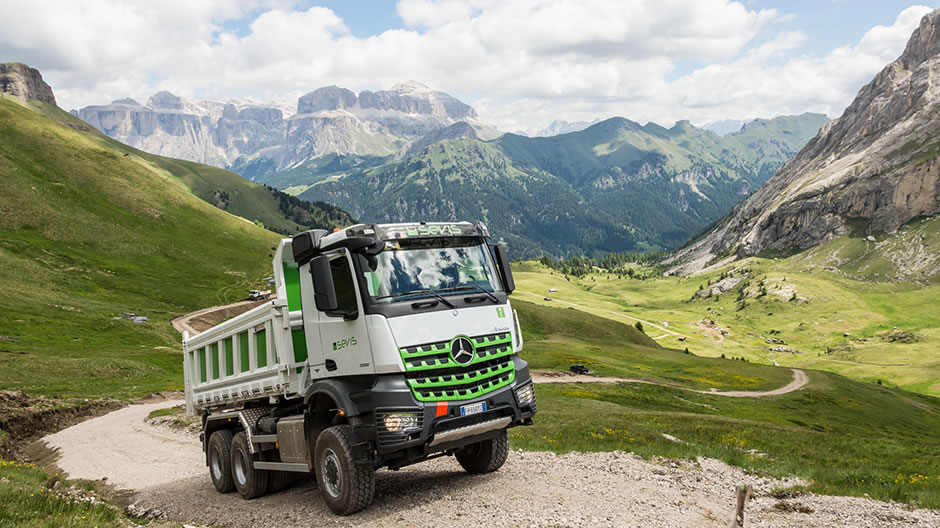
The Fassa Valley is a popular destination both for hikers and for mountaineers. Mountain tourists are very often drawn to the Ciampac valley basin. To get there you generally have to hike 1500 meters up to Alba di Canazei. From there, it is necessary to take the cable car to the valley basin 600 metres higher up. Due to construction work in the summer of 2017, the Alba di Canazei cable car station was suddenly closed down. In order to reach the Ciampac valley, excursionists now had to master a steep and winding gravel track.
From mountain infantryman to professional driver.
From time to time they met a very special mountaineer there: the Arocs from Sevis. This construction company, based in Moena in the province of Trento, is responsible for the complete renewal of the Ciampac cableway. At the wheel of the Arocs sits Dino Mattioli, a 44-year-old driver from the Fleims valley: "I have always been fascinated by heavy-goods vehicles, although no-one in my family had ever worked as a professional heavy vehicle driver. I got the opportunity to do this during my military service when I was employed as a driver by the mountain infantry and was able to get the necessary professional driving licences," he explains. Driving a vehicle for the mountain infantry means tackling impassable terrain from the very outset. With this training, Dino was able to immediately take on a job as a truck driver for construction sites when his military service ended. "Shortly thereafter I met up with Sevis and have been working for them for 19 years now."
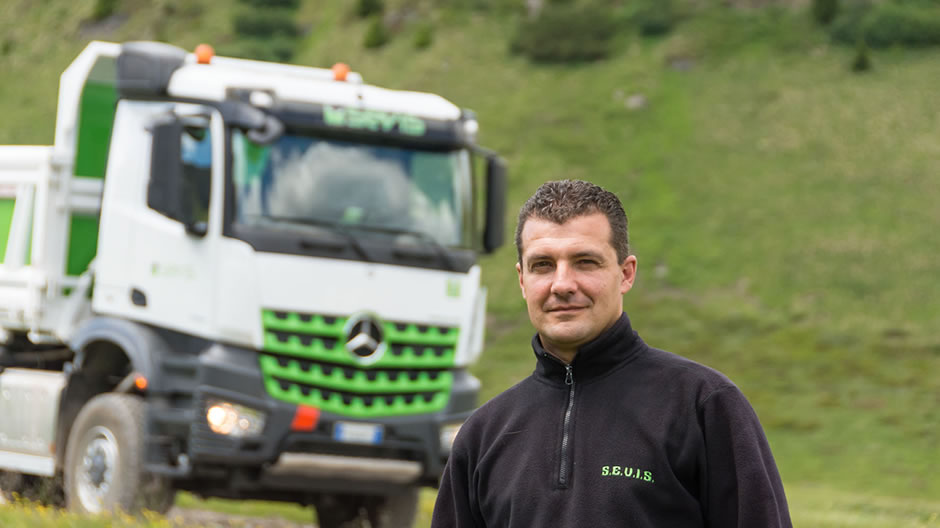
Experts for rough terrain: during his service time with the mountain infantry, Dino learned to drive in the mountains.
Highly demanding construction work.
Work at the Ciampac worksite is arduous: Sevis first has to dismantle and then rebuild a cableway cabin leading from Alba di Canazei to the high valley basin floor, and a chairlift that leads from the basin up to a mountain ridge 2600 metres above sea level. "With the Arocs we work both routes, but the first one is the most difficult because the gravel track is narrow, runs along the edge of precipices, and has tight hairpin bends and gradients of up to 30 per cent," says Dino. This track existed before the construction work began, but it was insufficient to cope with the size and weight of a fully-loaded truck. Dino explains: "So we adapted the road. Despite the excavation work carried out, the track is still a challenge and requires constant concentration. I confess that I prefer to drive under such conditions rather than on paved roads in the valley, which are overcrowded by tourists in the summer. There you have to share the road with mobile homes, passenger cars, touring coaches, motorbikes and bicycles. Here, on the other hand, we only meet workmates and a few day trippers who want to reach the valley basin."
This article contains additional material (videos, images and reports etc.) for registered RoadStars members. In order to experience the article to the full, you need to log in with your RoadStars account or register for one free of charge.
Become a RoadStar and gain access to exclusive content and campaigns!
Login for RoadStars members
Not yet a member? Join RoadStars now
Obtain exclusive access to exciting events and activities which only RoadStars can offer.
Join RoadStarsVariety guaranteed.
Dino's work at Ciampac changes with the progress of the construction works. One thing that doesn't change at all, however, is that he has to get up early in order to be on site at seven o'clock in the morning: "As soon as I arrive, I get my instructions for the day ahead. In the first phase of the construction work, we transported all the material from the demolition of the old cableway down into the valley; then we began to transport the material needed for the construction of the new facility uphill and to provide the site with its daily needs. At times you have to go down into the valley several times a day, on other days you 'commute' between the base and the peak of the valley basin." On tracks such as these a driving error can have grievous consequences.
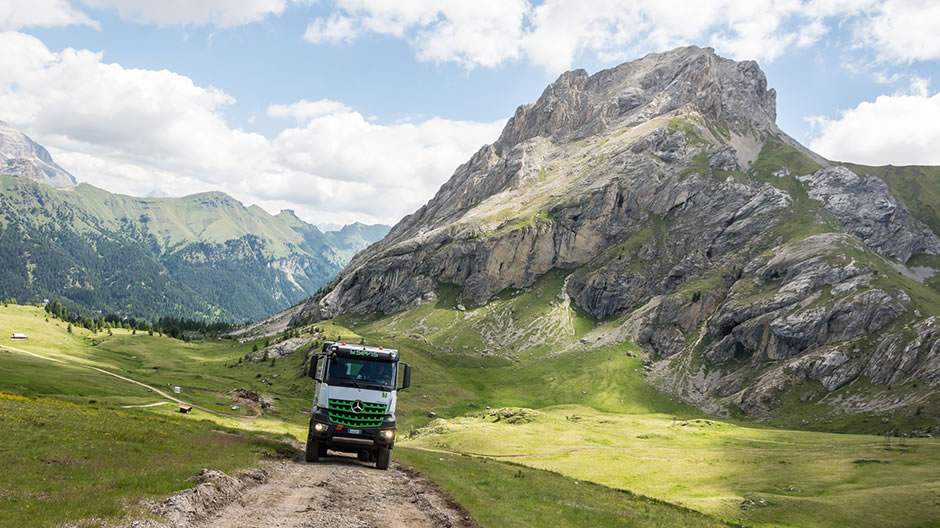
Commuting - with a splendid panorama: Dino and his Arocs tackle the stretch between the base and the summit of the high-mountain basin several times a day.
"The first, and fundamental, step to off-road driving is to know your own limits and those of the vehicle."
Dino Mattioli
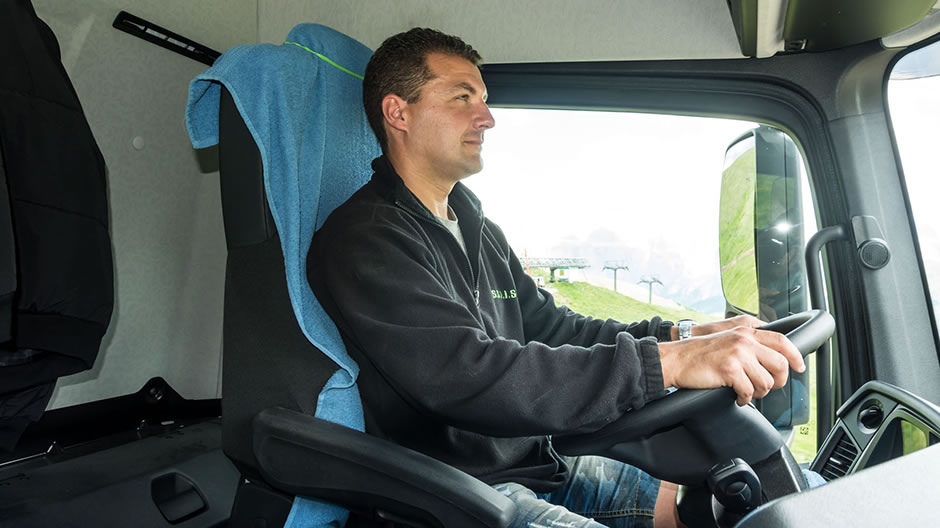
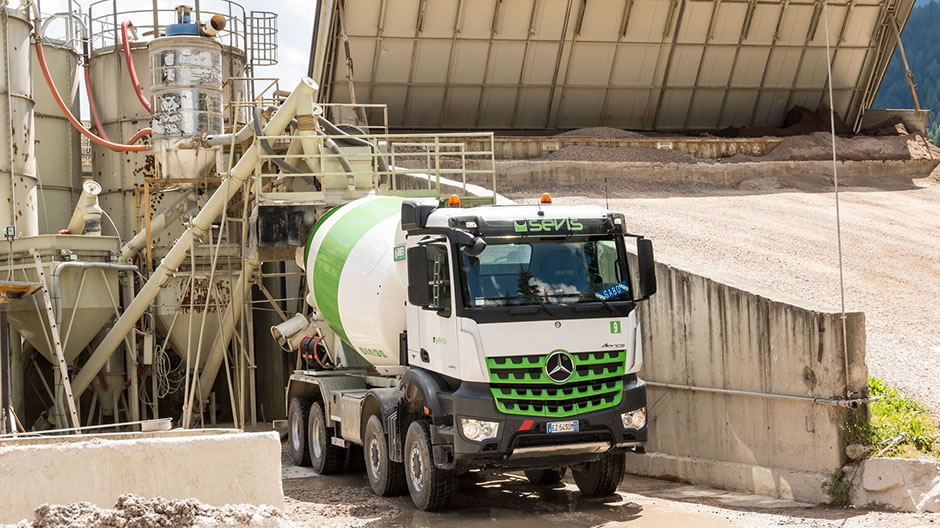
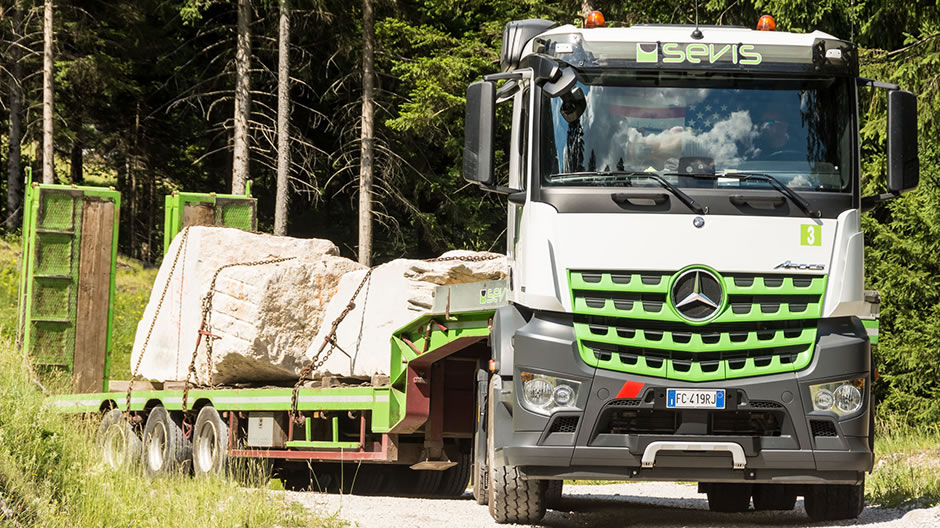
Knowing one's own limits.
"The first, and fundamental, step to off-road driving is to know your own limits and those of the vehicle. One has to know exactly what one can do and what one must avoid," explains Dino. "However, it is not audacious drivers who are needed for this work; but calm, prudent ones. They must also be familiar with steep gradients and the danger of slipping. Drivers who have already become acquainted with such situations as children riding a bicycle, then as youngsters on a motorcycle and then driving a car and finally as a truck driver. Because of this the company relies on people who were born here."
Always enough torque.
After seven years at the wheel of his Actros, Dino's working conditions improved significantly with the arrival of the Arocs. "I switched from a sequential shift with clutch to the Mercedes PowerShift 3 automatic transmission. It's easy to operate, and I want to be the one to tell the truck which gear it has to use on a steep downhill gradient. In both manual and automatic modes, the Arocs always shifts quickly and delivers the right torque for every situation."
Click here to leave RoadStars and to find out more information within Google Maps: Map on Google Maps
Photos & video: Michele Latorre




Comment
Please log in to post a comment.
19 comments
Ich fahre einen Actros 1843 Sattel und bin sehr zufrieden aber mein Chef hat an der falschen Stelle gespart, bei uns in der Gegend wäre ein 1853 besser gewesen.
Der kleine Motor reicht vielleicht für die Strecke aber im Nord Hessischen Bergland geht es viel Berg auf da hat er dann ganz schön zu knabbern und der Sprit verbrauch ist dann nicht so toll , trotzdem fahre ich ihn gerne ! 😍😊
Ich fahre einen Actros 1843 Sattel und bin sehr zufrieden aber mein Chef hat an der falschen Stelle gespart, bei uns in der Gegend wäre ein 1853 besser gewesen.
Der kleine Motor reicht vielleicht für die Strecke aber im Nord Hessischen Bergland geht es viel Berg auf da hat er dann ganz schön zu knabbern und der Sprit verbrauch ist dann nicht so toll , trotzdem fahre ich ihn gerne ! 😍😊
und gerade bei dem Panorama ...😃
und gerade bei dem Panorama ...😃
Gruß
Klaus
Gruß
Klaus
wir haben die Antwort: es ist ein Arocs 3351 - er hat also 510 PS 😊
wir haben die Antwort: es ist ein Arocs 3351 - er hat also 510 PS 😊
wir können die Zahl im Video auch nicht so recht entziffern, haben deine Frage aber an unseren Ansprechpartner bei Sevis weitergeleitet.
wir können die Zahl im Video auch nicht so recht entziffern, haben deine Frage aber an unseren Ansprechpartner bei Sevis weitergeleitet.
Gruß
Klaus
PS: "Da" stelle ich mir eine Turboretarderkupplung als zweckmäßig vor.
Gruß
Klaus
PS: "Da" stelle ich mir eine Turboretarderkupplung als zweckmäßig vor.